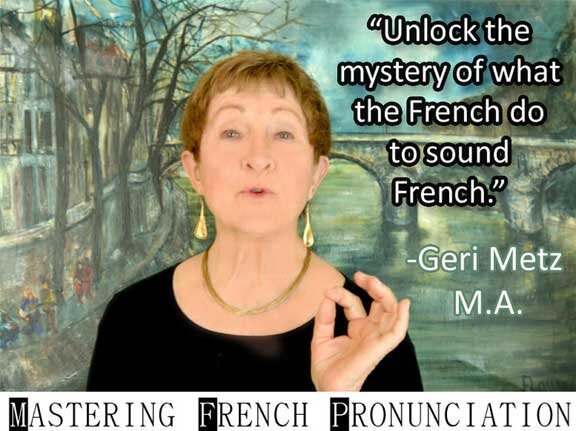Phoneme: a speech sound or utterance; a member of the set of the smallest units of speech that serve to distinguish one utterance from another in a language or dialect. A distinctive feature.
Phonetics: study of the sounds and the articulations of a language. Symbols which correspond to pronunciation.
Word Linking: L'enchaînement
In English there is a strong tendency to delimit the words in a sentence, to individualize them. They each have an identity. The same is true for syllables, where English closes off each syllable with a consonant sound, as seen in the lesson on “open syllabication”. In French, this is not the case at all. Open syllabication dominates even at the cost of words losing their identity in the spoken chain of syllables. This makes French hard to understand orally, but it is important and must be imitated.
Most of the cases of Word Linking are due to the French habit of open syllabication.
A. Consonant-Vowel linking:
Many of these linkings are from liaison, where a consonant not normally pronounced links to the following vowel as in mes amis, vous êtes, etc.
Other linkings occur when a final consonant that is normally pronounced links to an initial vowel in the following word, as in une année or avec elle. This kind of linking is called “élision”). Notice that these two are examples of the normal “open syllabication” that dominates French.
Elision: facile à dire; elle aussi; vers une heure; quelle histoire; votre élève;
Liaison: nous avons; ils ont; en Angleterre; deux hommes; les états.
B. Consonant-Consonant linking:
A word ending with a consonant links with a word beginning with a consonant sound: toute simple. This is the classic case of open syllabication, where the consonant from the first word is pronounced as if it were the first sound of the next word. This is how all the exercises in the Mastering French Pronunciation lessons are written because it makes it clear that the final consonant is sent on to the next syllable. This habit is also what causes cases of assimilation when the first consonant takes on the voicing or voicelessness of the second consonant.
Attrape-les /a tra ple/; coupe-tout /ku ptu/; ils savent /i /lsav/; /La musique l'a plu. /la my zi kla ply/) une faute de frappe /u nfo tdə frap/
C. Vowel-Vowel linking:
Two contiguous vowels link, merge, blend into each other. This one is more challenging for English speakers, since we launch each vowel with a glottal stop: an abrupt closing of the vocal cords. You hear this clearly in “ouch!” In the following examples, observe that no glottal stops are used between vowels. The voice is not interrupted, but only the tension reduced. Contrast the staccato series of glottal stops in the English: Abe ate an egg at eight.
Va à Arles et achète un hareng. Jean a eu un entretien idiot et inutile. Un garçon ennuyeux.
The mute e is pronounced in front of h aspiré:
Henri a été en haut. Une hache; cette hauteur. Il parle haut.
ASSIMILATION
Assimilation is the modification that a phoneme undergoes when it takes a distinctive feature from a contiguous phoneme. For the most part, this feature comes about due to the French language habit of open syllabication, and it only refers to consonants.
Because of open syllabication, two consonants often come together and in that case, the second consonant is predominant and gives its voicing or its voicelessness to the first consonant. Examples:
sac de couchage; medecin; absent; pas de quoi; rinse-doigts;
It is important to note that the /k/ of sac de couchage is voiced but does not become a /g/. If you said /sa gdə/ it would be noticeably false. To have an authentic pronunciation in these cases of assimilation, you must respect the intention of the speaker, which is to pronounce the consonants as they are spelled. But you give almost all of your energy to the second or dominant consonant, and let the first one just adapt automatically to the characteristics of the second.
Another, better, way to look at it is this: take the position of the first consonant—that is, place your tongue as if to pronounce that consonant, but don't actually say it. Say the second consonant, and you will fall right on the correct pronunciation. This is similar to the English word “empty” where the lips are closed for the “p” but it is not pronounced. The “t” is pronounced.
Exceptions:
No consonant becomes voiced or voiceless in front of /l/ or a nasal:
cette mère cette lampe
Words ending in -isme (romanticisme); Here there is no assimilation and the last syllable of these words is pronounced /is-mə/
If we listen to the French speaking English, this habit of assimilation becomes very evident. If you listen to any French person speaking English, like Géraldine of Comme Une Française, you will find many, many examples. Here are a few:
I like that: the /k/ of “like” is voiced by assimilation with the voiced “th” of “that”.
Black gloves: the “k” of “black” is voiced by assimilation with the voiced /g/ of “gloves”
at the end: the /t/ of “at” is voiced by assimilation with the voiced “th” of “the”
this video: the “s” of “this” is voiced by assimilation with the voiced “v” of video
step by step: the “p” of “step” is voiced by assimilation with the voiced “b” of “by”
Practice Exercises
des types de chez moi un groupe d'étudiants
une faute de frappe Ca me coute de l'argent
un sac de couchage des trucs de ce genre
mon chef de service On étouffe dans cette boîte
un rince-doigts espèce d'imbécile!
Plus de cinq ans Robert aide Papa
classisisme fanatisme humanisme Christianisme cubisme pacificisme
Due to the French habit of word linking, it is easy to create puns. Dr. Delattre says that French lends itself to puns more than any other language. Some examples follow:
1.Il y a cinq canards sur un tas de neige par un beau soleil.
Qu'est-ce qu'i(ls) font?---La neige.
2.Quelle est la fontaine de Paris qui donne la meilleure eau?
--La Fontaine Dauphine.
3.Quelle est la chose qu'on cherche quand on s'en dégoûte?
--Un parapluie.
4.De quelle couleur est un tiroir quand il n'est pas fermé?
--Il est tout vert.
5.Avez-vous déjà dîné?
--Non, je n'en ai encore qu'un.
6.Pourquoi ne faut-il pas trop bien nourrir un nain?
--Parce qu'on risque de faire un ingrat.
neige fond
la fontaine d'eau fine
quand on sent des gouttes
il est ouvert
un nez
un nain gras


